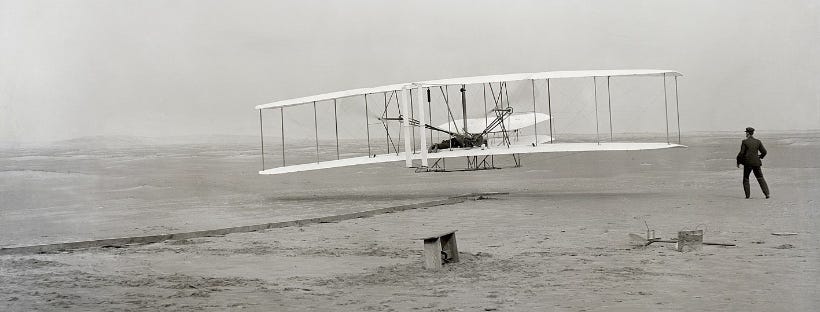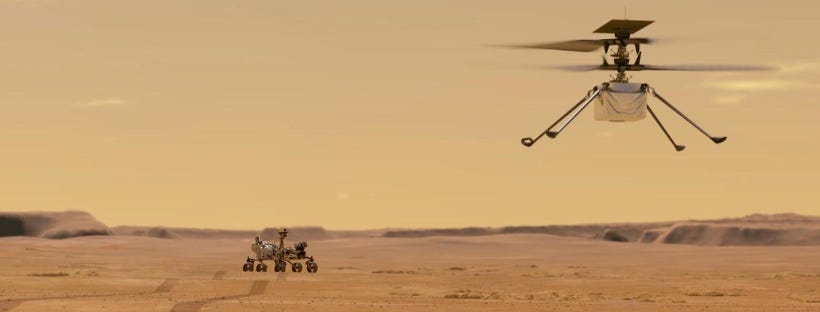About now that I write this, Sunday night in Ottawa, NASA's Ingenuity Mars Helicopter should have made history by making the first powered flight on another planet. But even on Mars, there are flight delays; its first experimental flight will not take place before Wednesday.
These are the eight things you need to know:
1. The helicopter is not broken
The small helicopter is safe and healthy, but NASA doesn't take any chances. Last Friday, NASA stopped a high-speed spin test of the rotors because the 'watchdog timer' alerted for a potential issue. The NASA team is now reviewing the test before they can continue.
2. Postponing your first powered flight on a planet is a good tradition.
The Wright brothers did the same 117 years ago. Both brothers were eager to be the first, so they tossed a coin. Wilbur won but ruined his chance by climbing too steeply, followed by a dive in the sand of the Outer Banks, south of Kitty Hawk in North Carolina.
A few days later, it was Orville's turn, and he managed to fly 120 feet. After three more test flights, they set their record that day at 852 feet in 59 seconds. It would take more than a hundred years before we started to think seriously about flying in the thin atmosphere of another planet. This month, Ingenuity will attempt up to five test flights on the Red Planet. NASA's pioneering aspirations are in many ways similar to those of the Wright brothers.
A century later, the rotor still looks a bit like the airplane-propeller that the Wright brothers also invented. I admire their creativity; they could hardly use ship propellers' science; it's an entirely different design. The same goes for the invention of their airplane. A modern aircraft still has the same basic structure, unlike Otto Lilienthal's glider designs that looked more like bird wings.
In 2014, I saw the Wright Brothers’ original plane for the first time in the National Air and Space Museum in Washington DC. That was fascinating; don't miss it if you are someday in Washington and don't miss the Spirit of St. Louis and the Apollo 11 capsule; in short, this museum is one for your bucket list.
3. The helicopter does not carry science instruments
The test is about testing technology and demonstrating that a rotorcraft flight in the extremely thin atmosphere of Mars is possible.
4. It is cold in the Jezero Crater.
At night it gets as cold as minus 130 degrees Fahrenheit (minus 90 degrees Celsius). These temperatures will push the original design limits of the off-the-shelf parts used in Ingenuity. Tests on Earth at the predicted temperatures indicate they should work as designed, but the real test will soon occur at Mars. So far, so good: Ingenuity has survived the first cold nights
5. 'Into thin air.'
The atmosphere on mars is about 1% of the density of our atmosphere on Earth. Because the Mars atmosphere is so much less dense, Ingenuity has a light design, and it needed much larger rotor blades that spin much faster than a helicopter of Ingenuity's mass on Earth would need. Mars does help a little, with a gravity of about one-third that of Earth's. That means slightly more mass can be lifted at a given spin rate.
6. Ingenuity is clever for a small robot.
Ingenuity is too far from Earth to control its flight with a kind of play station tool. So NASA made it an intelligent little helicopter to do quite a few things by itself. It analyzes sensor data and images of the terrain to ensure it stays on the flight path programmed by project engineers and can make some decisions independently.
7. Ingenuity has already pushed the boundaries of flight.
It took humankind centuries to figure out how to fly planes and helicopters on Earth. In many small steps over six years, engineers on the Ingenuity team demonstrated that it was possible to build something ultra-lightweight that could take off from the ground, fly in Mars' thin atmosphere, and operate and survive autonomously in the challenging Martian environment. We will soon know if flying over the surface of Mars is possible. It would confirm results from flight tests performed in unique space simulation chambers and provide insights into operating a helicopter on Mars.
8. The Ingenuity test may lead to new possibilities for Mars exploration in the future.
Other robotic flying vehicles could play a role in guiding rovers on the ground during future robotic or human missions to Mars by providing detailed terrain images. They could also go to areas that are hard to reach for rovers or humans, and these kinds of helicopters could even transport light but essential payloads.
If you don’t believe that anyone should write for free, and if you like what you read, please consider taking a paid subscription to this newsletter. It supports my work and also makes it possible for those who can’t pay to keep reading The Planet.
Notes:
https://www.nps.gov/wrbr/learn/historyculture/thefirstflight.htm
The picture of the first flight: By John T. Daniels - File:Wright_first_flight.tif, Public Domain, https://commons.wikimedia.org/w/index.php?curid=75148383
All other pictures and video from NASA
https://www.jpl.nasa.gov/









An awesome read Alexander, it feels like I landed on Mars this morning via the Wrights brothers desire to fly. This is an incredible mission we can witness in our only lifetime. I was not aware of Ingenuity, Mars helicopter' baby steps. Thank you for writing about this historical sequence made possible by inventors, engineers and Hi Tech scientist up to this point, today! Wednesday I will look up to Mars and think about this ongoing event (-: